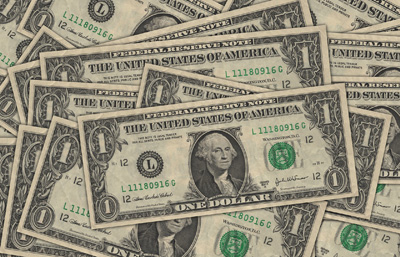BRICS vs the U.S. Dollar: An Inevitable Showdown?
Michael Snyder
 The Dollar’s Decline Opens the Door for Rivals The Dollar’s Decline Opens the Door for Rivals
With all eyes on BRICS as it prepares for a meeting at the end of August that could see new members joining, the question is looming in the back of future-minded investors: will BRICS develop its own currency in a bid to challenge the U.S. dollar as the world standard?
The possibility of BRICS launching its own currency is a real one, with prominent member states China and Russia each expressing their desire to move away from the dollar. Russia in particular is leading the charge for BRICS to develop currency.
Deputy Chairman of the State Duma Alexander Babakov spoke in March 2023 of the need for a “common currency” between India and Russia and how it would enable greater trade between the two economic powerhouses. Babakov went on to say how bringing China into the trio would make sense. “New Delhi, Beijing and Moscow are the nations that now institute a multipolar world that is endorsed by the majority of governments. Its composition should be based on inducting new monetary ties established on a strategy that does not defend the U.S.’s dollar or euro, but rather forms a new currency competent of benefiting our shared objectives,” he said.
With just its original members, BRICS already represents a third of the world’s economic power – surpassing the G7 for the first time last year. On top of that, BRICS signaled a few years ago that it was time to expand the bloc, leading new potential members – some of which are the largest economies in the world – to formally tender their applications. With more members incoming, experts are projecting that BRICS will represent a full 50 percent of the world’s GDP by 2030.
Can BRICS replace the dollar?
It’s not an accident that BRICS is expanding now. The strategic economic partnership between the original members of BRICS has said from the beginning that it believes “that there is a strong need for a stable, predictable and more diversified international monetary system,” and that by including more voices at the table, that can be achieved. With more member states in BRICS, and a greater share of the world’s GDP, the likelihood that a new currency would be successfully launched increases all the more.
All of this is occurring at a time when the U.S. dollar has been significantly weakening on the world stage and domestically. Since 1933, the value of the dollar has decreased by 96%. If inflation continues at a moderate rate of 3% a year, then $100 today will be worth under $80 in 2030. Talk about a bad investment! De-dollarization seems to be on the horizon, and BRICS certainly hopes to take advantage of this moment.
With a recession predicted for the end of 2023, it’s been enough for the U.S. to receive a downgraded credit rating (going from AAA to AA+), which has only further influenced investors to look for an alternative currency to back.
Some consider the U.S.’s switch to a purely fiat currency to be the primary undoing of the dollar. That happened back in 1977 when the dollar was formally severed from the value of gold. Since then, the main selling point of the dollar has rested purely upon the reputation of the U.S. government. As that reputation crumbles on the world stage due to decades of interventions, financial sanctions, and trade embargoes, the value of the dollar similarly declines.
With the limitations of fiat currencies in mind, Russia has suggested that a new currency from BRICS would be backed by gold, which would endear it to investors and catapult it to a level of legitimacy quickly on the world stage. Having a gold-backed currency available to traders around the world would also be a surefire way to draw investors away from the volatile dollar.
Now, this isn’t necessarily a sure thing… Despite the official confirmation of a gold-backed BRICS currency announcement from Russia, both India and South Africa publicly announced that’s not on their August 22nd agenda.
On the other hand, China has been steadily increasing its gold reserves (and, quite unusually, announcing this publicly). With the addition of 23 tons in July, China’s official gold holdings rose to 2,136 tons. That’s the ninth consecutive month of gold purchases, for a total increase of 188 tons to China’s central bank gold reserves.
While all of the dominoes leading to a new BRICS currency appear to be lined up, it will realistically take some time for it to be developed and for a safe and efficient monetary system to be integrated across the member and non-member nations. It took ten years for the euro to be designed, and while BRICS has a few advantages coming into the process – including the development of widespread electronic payments – it will likely take at least a fraction of that time before investors have the opportunity to trade with the new currency.
 With your retirement at stake, you want to be confident in the financial services companies that you work with—including whom you choose for purchasing physical precious metals. With your retirement at stake, you want to be confident in the financial services companies that you work with—including whom you choose for purchasing physical precious metals.
You need to put your savings into the hands of an experienced and well-respected dealer in gold, silver and other precious metals. Sleep better at night with a proven industry leader in your corner, someone who can show you how precious metal investments can protect your lifestyle and retirement—even when the economy gets shaky.
Birch Gold Group is that trusted leader, proudly celebrated by our customers, the industry, and major media leaders alike.
www.birchgold.com
| ![[Most Recent Quotes from www.kitco.com]](http://www.kitconet.com/images/live/s_gold.gif)
![[Most Recent USD from www.kitco.com]](http://www.weblinks247.com/indexes/idx24_usd_en_2.gif)
![[Most Recent Quotes from www.kitco.com]](http://www.kitconet.com/images/live/s_silv.gif)


